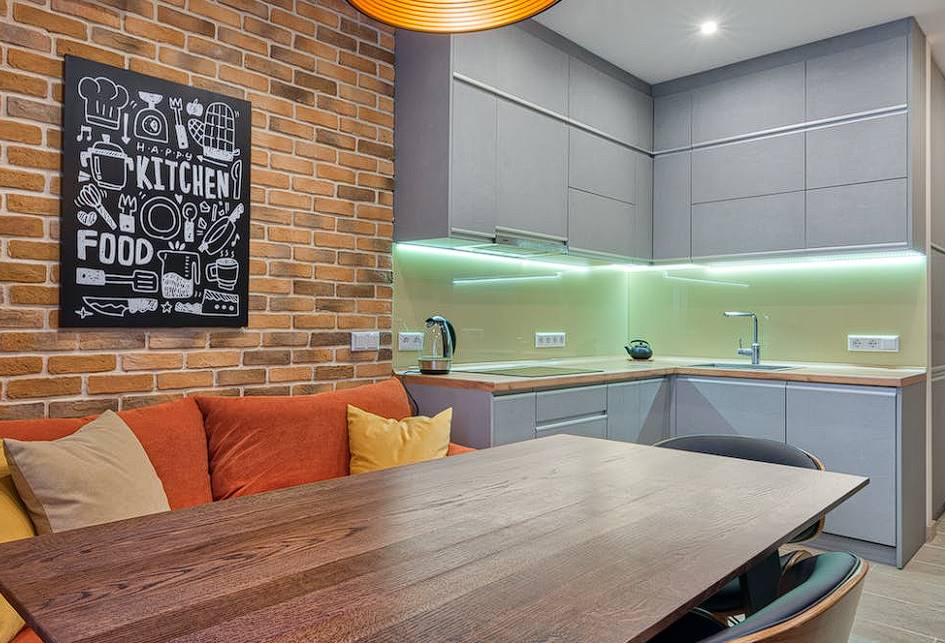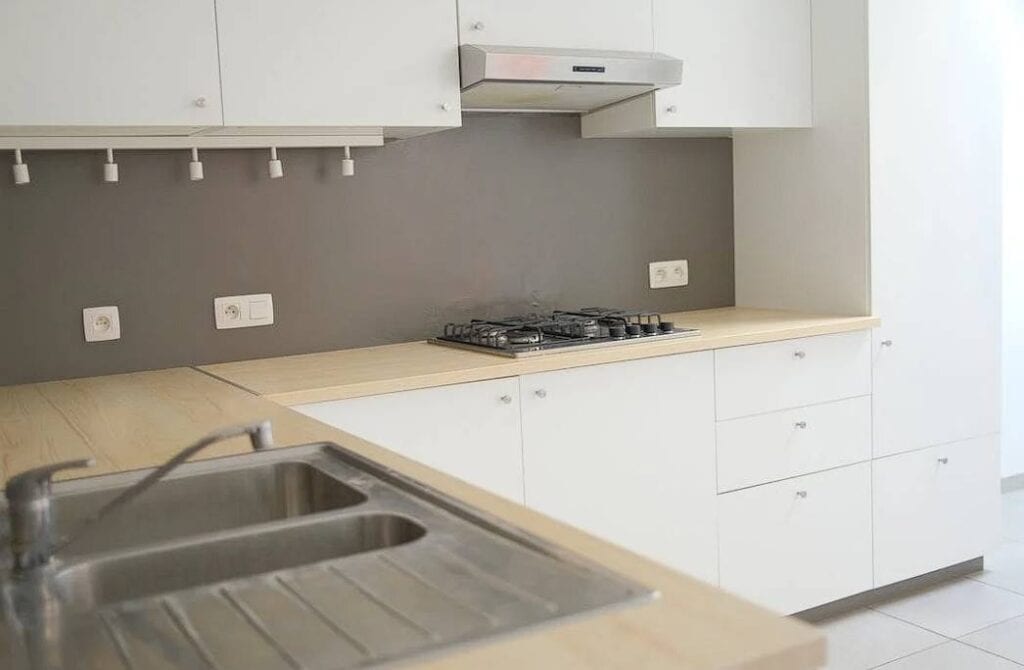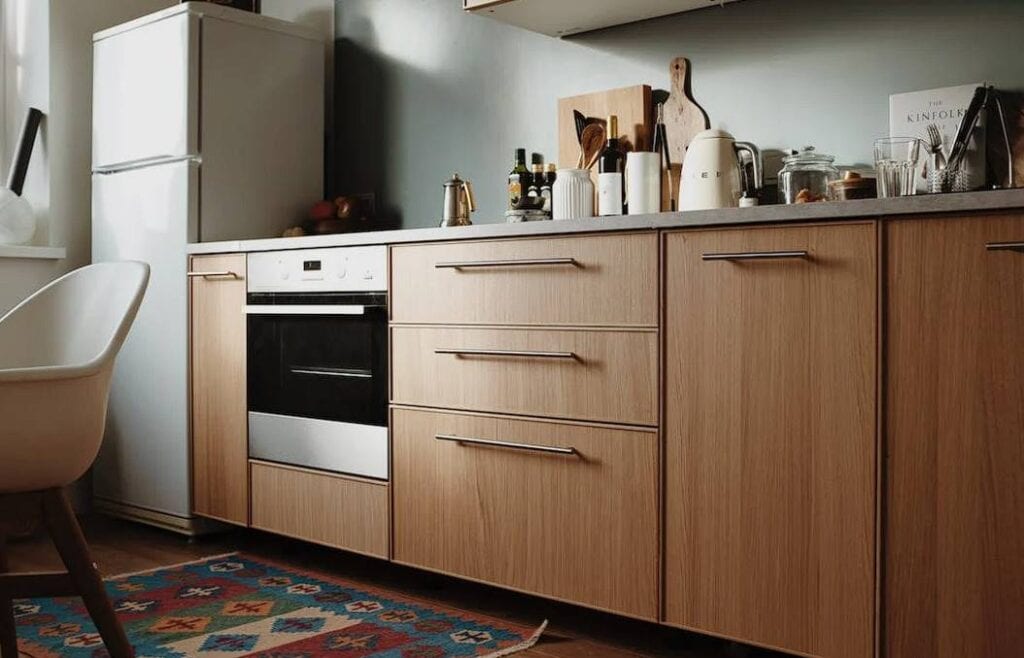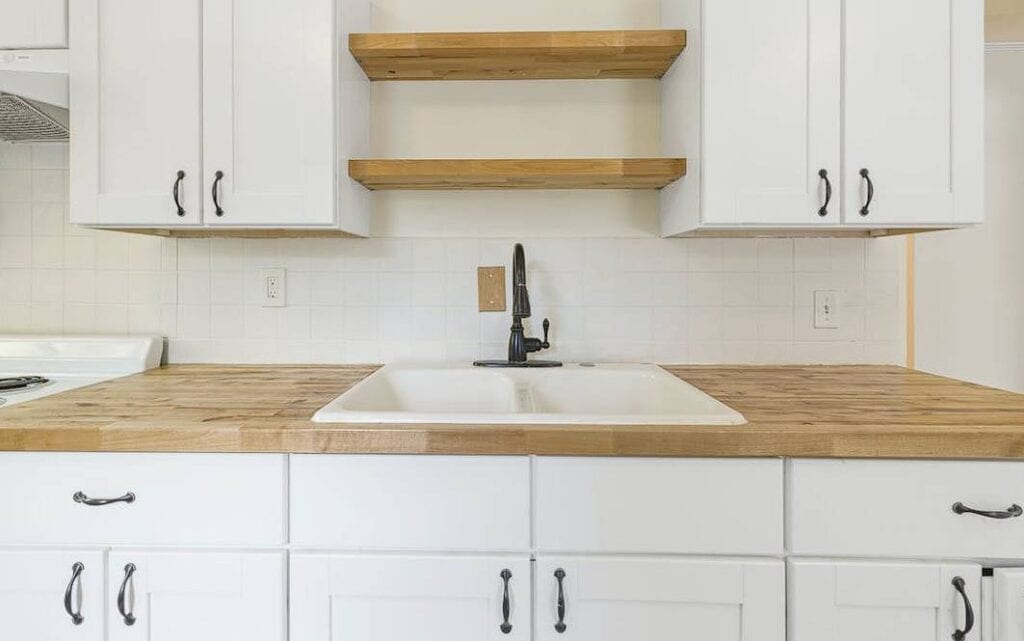Changing the colour of your kitchen cabinets can be fun and stressful. Because cabinets are an integral part of the kitchen's decor, the colour you choose will significantly impact you. A well-chosen colour scheme can do wonders for a room's aesthetic, mood, and even how it's perceived in terms of size. However, there are many colour alternatives, so you'll want to consider a few things to pick the right one. This guide will help you choose a colour for your kitchen cabinets that is complementary to the rest of your space and reflective of your individual design.
What Colour Should My Kitchen Cabinets Be?
Consider the mood you want to create to begin picking out kitchen cabinet colours. Then, consider how it will work in the context of the rest of the house, including the living room and the kitchen, if they are an open concept.
Start refining your vision by collecting pictures of kitchens that appeal to you, then consider how those designs might work with the rest of your home's woodwork and the age of your building.

How To Choose Kitchen Cabinet Colors
Consider Light And Direction When Choosing Colours
It's tempting to pick a kitchen cabinet colour you adore right from the showroom, but keep in mind that it'll probably look very different in your actual kitchen. The amount of natural light entering the space, the room's position, and other factors will heavily influence your colour choice.
Kitchens that are cramped or poorly lighted benefit from using kitchen cabinet colour ideas that are on the mellower or cooler side. Furthermore, a high-gloss paint finish can amp up the room's ambience by creating depth and adding moodiness via its watery effect. The amount and quality of natural light entering a room (or lack thereof) can have a dramatic effect on the colours used in the room.
.
Consider Utilising Different Colours For Upper And Lower Cabinets.
Painting kitchen cabinets creatively can help break up the monotony of an otherwise visually heavy room. In a tiny kitchen plan, mounting lighter cabinets on the walls can assist them visually recede, preventing the area from feeling top heavy, while dark units for the base of the room are a fantastic idea. If you have pets or young children, a lighter colour for your kitchen's base cabinets might not be the best idea.
Consider Colour, Tone, And Texture Combinations
The best colour schemes for a kitchen are the ones that make you happy. Because kitchens are rarely redecorated, it's crucial to pick hues that truly inspire you rather than those you assume will be popular.
Paints Vs Stains
Cabinets in the kitchen are typically painted rather than stained. Painted cabinets are common because of their variety, adaptability, and low maintenance requirements. Also appealing to designers is the versatility of lacquer in terms of colour, texture, and overall aesthetic. Kitchens can be made to look smaller, larger, cosier, cooler, gourmet, or more at home with the help of the correct paint selections.
Scratches in paint are difficult to repair, but the surface can be painted over in the same or a different colour for a completely different effect. Additionally, most painted cabinets are inexpensive because they are made from MDF.
For expansive kitchens, stains present a novel design opportunity. The enough square footage provides enough clearance for the stained cabinetry, which in turn lends the kitchen an inviting and homey atmosphere. Staining some cabinets and lacquering or metallicizing others makes for an interesting diversity. This adds visual flair and a contemporary feel to an otherwise staid kitchen. This helps keep the stained cabinetry from being too dominant.
Cabinets with a natural, unstained finish are more popular than painted ones because the latter show more signs of scuffing after prolonged use.
Colours To Consider For Kitchen Cabinets
Which Cabinet Colour Is Best For You: Light Side Vs. Dark Side?
The kitchen is the social core of the house. Guests are more likely to congregate in the kitchen, regardless of how welcoming the rest of your home is. It is important to consider how you want your kitchen to feel when choosing between light and dark cabinets because each may have a dramatic effect on the room. Here are some benefits and drawbacks of each finish to help you decide.
Light Kitchen
Traditional And Trend-Proof
You can probably count on white or other light-coloured cabinets staying in style for quite some time. They've been a go-to for house sellers for decades, and they still deliver the best results. White cabinets are adaptable and may be paired with various wall colours, countertops, and backsplashes. Whether your kitchen design aesthetic leans towards modern, contemporary, traditional, or rural styles, lighter cabinets will help you easily realise your vision. If your kitchen has become stale over a few years, a fresh coat of paint and new accessories will do wonders without breaking the bank on brand-new cabinets.
Clear & Brilliant
If your kitchen is smaller, you'll find that lighter-coloured cabinetry works well. They improve the quality of artificial and natural light in the kitchen, making it more modern and inviting. In addition, white cabinets give off an image of cleanliness and tidiness while making your kitchen feel bright and open.
Maintenance On A Light Cabinet
The dirt and grime accumulating on white or light-coloured cabinets are easily visible, making continuous cleaning necessary. Those with young children or a sizable household should consider this seriously. Cracks, discolouration, and other telltale signs of wear and tear may appear on them sooner than on their dark counterpart.
Dark Kitchen
Fancy And Formal
A kitchen with dark cabinets may be both cosy and sophisticated. They give your kitchen an air of refined elegance and sophistication.
Design Is Important
While white cabinets may be used in almost any setting, darker cabinets are more challenging to style successfully. Because of this, designing a dark kitchen takes more skill. For example, adding dark cabinets to a small, dimly light kitchen can make the space feel even smaller and more cramped. Similarly, dark kitchens require bright accents to balance out the dark cabinets. Finally, to avoid your kitchen feeling like a cave, consider using countertops or flooring in a lighter colour to create contrast.
Trends Adapt
While dark cabinets are on-trend, research shows they won't last as long as their lighter-coloured counterparts. Because paints and stains are regularly updated to reflect modern tastes, the colour you have now may look antiquated in no time. So if you want to sell your house soon, consider this.
Maintenance On A Dark Cabinet
Kitchens with high use or little children running around benefit greatly from dark cabinets because they hide dirt and filth.
Benefiting From Both The Darkness And The Light
You don't have to pick between light and dark cabinetry if you can't decide. It helps to understand how to work with nature. If you want to avoid the room being too top-heavy and imbalanced, try painting the wall cabinets a light colour and the base cabinets a darker one. You could also switch things up by selecting white cabinets for the island and dark ones for the walls and base.
A Single Colour In Several Shades
Put to use contrasting shades of the same colour to strike a balance between the extremes of utilising all neutrals or all bright colours. You can create a dramatic contrast by painting your upper cabinets a dark grey or tan and your bottom cabinets a lighter shade of the same colour (or vice versa). This method maintains a sense of neutrality while also enhancing the visual appeal.
If you want your cabinets to look great for years to come, whether you're painting the ones you have or buying brand new ones, make sure they're well-made and painted.

The Top 10 Most Popular Kitchen Colours Are:
White
A white kitchen that's been meticulously cleaned can look like it was plucked straight from a design magazine. A warmer off-white can be complemented with natural woods, marble, and great accessories. At the same time, the bright white is perfect for a minimalist design plan consisting of clean lines and sleek cabinetry.
Black
A well-executed black kitchen is sleek and uncluttered, opening the door to various complementary colour palettes and metal accents. Black kitchens are striking because of their bold and sombre expression, but they can be difficult to pull off properly.
Grey
One of the more elegant kitchen colours, matt charcoal cabinetry and warm oak surfaces, sleek metalwork, and modern, clean lines are perfect complements to this shade. And it works wonderfully as a backdrop for a wide range of hues, from baby blue to deep burgundy.
Green
This colour is so popular in contemporary kitchens because of the range of green tones from dark forest and olive to lighter eucalyptus and sage. Green's energising and calming properties stem from its associations with nature and ability to conjure thoughts of balance, development, renewal, and harmony in the home's busiest space.
Blue
Inky blue, a more forgiving tint than pure black, is typically contrasted with lighter elements, such as wood flooring or white counters, to avoid creating a foreboding atmosphere. Teal and sapphire, on the other hand, have deeper overtones of green that complement brass and gold.
Cream
Despite being the epitome of adaptability, traditional cream was less popular than one might think. Cream, which has warmer overtones than pure white, pairs well with rich metallics (such as the copper pots and accessories shown here) and red or yellow woods. With neutrals, you can make your kitchen feel both airy and bright. Cabinets in a neutral kitchen should be paired with walls and textures that stand out. Adding this detail will set the design apart and add visual appeal.
Red
Red is a terrific option when trying to brighten up a space that doesn't get a lot of natural light. However, if you're worried about your reds looking too bright or flashy, pair them with raw materials like natural wood and stone.
Pink
It takes a discerning eye to prevent a sickly result in a pink kitchen. Shaker cabinets in a rich or chalky shade of pink are a stylish option. Pink goes beautifully with rich blues and brass.
Yellow
The space is instantly animated by a warm and brilliant yolky yellow, which also serves as a deceptively adaptable backdrop for accents in primary blue, a rich purple, sky blue, and even burnt orange.
Brown
Tenth-placed, warm and luxurious colour. Mixing browns is simple as long as the finishes are consistent; keep the lacquered woods and the rougher raw finishes apart. The pure white of marble is often paired with other complementary colours.
Conclusion
The choice of kitchen cabinet colours can significantly impact a room's aesthetic, mood, and size. To choose the right color, consider the mood you want to create, the context of the rest of the house, and the age of your building. Consider the amount of natural light entering the space, the room's position, and other factors when choosing colors. Use different colors for upper and lower cabinets to break up the monotony of an otherwise visually heavy room. Consider colour, tone, and texture combinations to make the best choice.
Painted cabinets are common due to their variety, adaptability, and low maintenance requirements. Stains offer a novel design opportunity for expansive kitchens, providing a contemporary feel and visual flair. Natural, unstained cabinets are more popular than painted ones because they show more signs of scuffing after prolonged use.
When choosing between light and dark cabinets, consider the benefits and drawbacks of each finish. Light cabinets are traditional and trend-proof, paired with various wall colors, countertops, and backsplashes. They are adaptable and can be paired with various wall colors, countertops, and backsplashes. They are also clear and brilliant, making the kitchen feel modern and inviting.
Maintenance on light cabinets is essential, as dirt and grime accumulating on them are easily visible. For small, dimly light kitchens, adding dark cabinets can make the space feel even smaller and more cramped. Dark cabinets require bright accents to balance out the dark cabinets. To avoid a cave-like kitchen, consider using countertops or flooring in a lighter color to create contrast.
Dark cabinets are on-trend, but they may not last as long as lighter-colored counterparts. Kitchens with high use or little children can benefit greatly from dark cabinets, hiding dirt and filth.
Benefiting from both light and dark cabinetry can be achieved by working with nature. For example, painting the wall cabinets a light color and the base cabinets a darker one, or selecting white cabinets for the island and dark ones for the walls and base. A single colour in several shades can create a balance between neutral and bright colors in a kitchen. To maintain a sense of neutrality and enhance visual appeal, paint upper cabinets in dark grey or tan and lower cabinets in lighter shades of the same color. The top 10 most popular kitchen colours are white, black, grey, green, blue, cream, red, pink, yellow, and brown.
White is perfect for minimalist designs with clean lines and sleek cabinetry, while black is sleek and uncluttered. Green is popular for its calming properties and associations with nature. Blue is a more forgiving tint that complements lighter elements, while cream is more adaptable and pairs well with rich metallics and red or yellow woods. Red is a great option for brightening spaces without much natural light, but should be paired with raw materials like natural wood and stone. Pink is a stylish option with shaker cabinets in a rich or chalky shade, while yellow is a warm and luxurious color that can be paired with accents in primary blue, purple, sky blue, and burnt orange.
Content Summary:
- Changing the colour of your kitchen cabinets can be fun and stressful.
- This guide will help you choose a colour for your kitchen cabinets that is complementary to the rest of your space and reflective of your individual design.
- Consider the mood you want to create to begin picking out kitchen cabinet colours.
- Kitchens that are cramped or poorly lighted benefit from using kitchen cabinet colour ideas that are on the mellower or cooler side.
- Furthermore, a high-gloss paint finish can amp up the room's ambience by creating depth and adding moodiness via its watery effect.
- Painting kitchen cabinets creatively can help break up the monotony of an otherwise visually heavy room.
- If you have pets or young children, a lighter colour for your kitchen's base cabinets might not be the best idea.
- The best colour schemes for a kitchen are the ones that make you happy.
- Cabinets in the kitchen are typically painted rather than stained.
- The kitchen is the social core of the house.
- It is important to consider how you want your kitchen to feel when choosing between light and dark cabinets because each may have a dramatic effect on the room.
- Here are some benefits and drawbacks of each finish to help you decide.
- You can probably count on white or other light-coloured cabinets staying in style for quite some time.
- If your kitchen is smaller, you'll find that lighter-coloured cabinetry works well.
- The dirt and grime accumulating on white or light-coloured cabinets are easily visible, making continuous cleaning necessary.
- A kitchen with dark cabinets may be both cosy and sophisticated.
- They give your kitchen an air of refined elegance and sophistication.
- While white cabinets may be used in almost any setting, darker cabinets are more challenging to style successfully.
- Because of this, designing a dark kitchen takes more skill.
- Similarly, dark kitchens require bright accents to balance out the dark cabinets.
- Finally, to avoid your kitchen feeling like a cave, consider using countertops or flooring in a lighter colour to create contrast.
- Trends Adapt While dark cabinets are on-trend, research shows they won't last as long as their lighter-coloured counterparts.
- So if you want to sell your house soon, consider this.
- You don't have to pick between light and dark cabinetry if you can't decide.
- If you want to avoid the room being too top-heavy and imbalanced, try painting the wall cabinets a light colour and the base cabinets a darker one.
- You could also switch things up by selecting white cabinets for the island and dark ones for the walls and base.
- Put to use contrasting shades of the same colour to strike a balance between the extremes of utilising all neutrals or all bright colours.
- You can create a dramatic contrast by painting your upper cabinets a dark grey or tan and your bottom cabinets a lighter shade of the same colour (or vice versa).
- If you want your cabinets to look great for years to come, whether you're painting the ones you have or buying brand new ones, make sure they're well-made and painted.
- A white kitchen that's been meticulously cleaned can look like it was plucked straight from a design magazine.
- At the same time, the bright white is perfect for a minimalist design plan consisting of clean lines and sleek cabinetry.
- A well-executed black kitchen is sleek and uncluttered, opening the door to various complementary colour palettes and metal accents.
- And it works wonderfully as a backdrop for a wide range of hues, from baby blue to deep burgundy.
- Teal and sapphire, on the other hand, have deeper overtones of green that complement brass and gold.
- Cream, which has warmer overtones than pure white, pairs well with rich metallics (such as the copper pots and accessories shown here) and red or yellow woods.
- With neutrals, you can make your kitchen feel both airy and bright.
- Cabinets in a neutral kitchen should be paired with walls and textures that stand out.
- Red is a terrific option when trying to brighten up a space that doesn't get a lot of natural light.
- It takes a discerning eye to prevent a sickly result in a pink kitchen.
- Shaker cabinets in a rich or chalky shade of pink are a stylish option.
- Pink goes beautifully with rich blues and brass.
- The space is instantly animated by a warm and brilliant yolky yellow, which also serves as a deceptively adaptable backdrop for accents in primary blue, a rich purple, sky blue, and even burnt orange.
- Tenth-placed, warm and luxurious colour.
- The pure white of marble is often paired with other complementary colours.
Frequently Asked Questions
White is the most classic choice for cabinets because of its longevity in the design world (almost fifty years). In addition, white cabinetry is hard to top regarding aesthetics. They make the space feel brighter and more open.
Kitchen design and painting professionals agree that dark blue and white are equally popular. However, painting the kitchen a bright white is a common recommendation of real estate agents and home stagers who want to make the room more spacious and bright.
Traditional kitchens are easily recognisable by their creamy white cabinetry. The lovely Craftsman-style cabinetry in this kitchen stands out against the sunny yellow walls thanks to the use of dark stone worktops and a fresh coat of white paint.
Use light colours. Since light colours reflect more light than dark colours, they will give the impression that your kitchen is bigger and more airy. Other excellent colours to make your area appear larger than life include light blues, greens, or pastel yellows..
Beiges and creams may make a kitchen appear luxurious and pricey. If your kitchen is contemporary, using dark hues like black and grey can make it appear opulent and luxurious. Add some wood and metallic accents to balance off the white, which reflects light and enlarges the room.


